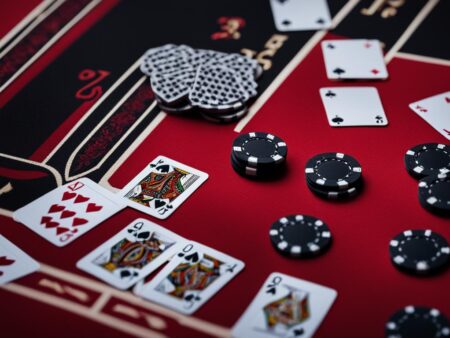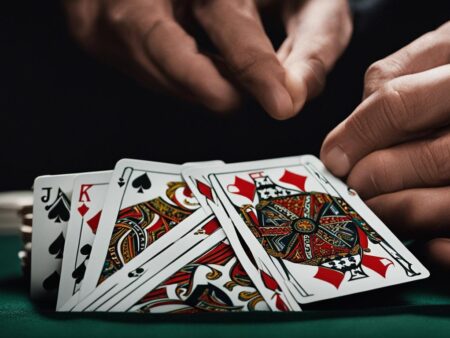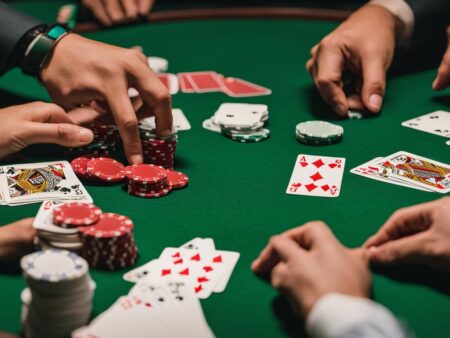When it comes to playing blackjack, understanding the odds can greatly impact your chances of winning. With the right strategy, you can increase your likelihood of success and minimize your losses. In this article, we will delve into the world of blackjack odds and explore how perfect strategy can make a difference in your gameplay.
Key Takeaways:
- By learning and applying basic strategy, you can reduce the house edge and improve your odds of winning.
- Understanding probability and how it affects blackjack odds is crucial for maximizing payouts and minimizing losses.
- The dealer’s odds can vary depending on the blackjack house rules, so it’s important to familiarize yourself with these rules.
- Knowing when to hit and when to stand based on the dealer’s upcard can significantly improve your chances of winning.
- Using blackjack odds to your advantage in tricky hands can help you make strategic choices and increase your chances of victory.
Player’s Odds Table
Understanding the odds in blackjack is essential for maximizing your chances of winning. By following basic strategy and employing card counting techniques, you can significantly reduce the house edge and increase your odds of success. To help you make informed decisions at the blackjack table, we have compiled a comprehensive player’s odds table.
| Hand Value | Dealer’s Upcard | Odds of Choosing to Hit |
|---|---|---|
| 5-8 | 2-6 | Hit |
| 9 | 2-6 | Double if possible, otherwise Hit |
| 10 | 2-9 | Double if possible, otherwise Hit |
| 11 | All | Double |
| 12 | 4-6 | Stand |
| 13-16 | 2-6 | Stand |
| 17 or more | All | Stand |
As you can see from the player’s odds table, the decision to hit or stand is based on your hand value and the dealer’s upcard. Following this table will help you make strategic choices that give you the best chance of beating the dealer. It’s important to note that more advanced techniques, such as card counting, can further improve your return-to-player percentage (RTP).
While card counting is a powerful technique, it requires practice and skill to implement effectively. It involves mentally keeping track of the ratio of high to low cards in the deck, allowing you to adjust your bets and playing decisions accordingly. By exploiting the favorable situations that arise from card counting, you can tilt the odds in your favor and increase your chances of winning.
Player’s Odds Table
When using the player’s odds table, remember that it is a general guide and may not apply to every specific situation. Variations in blackjack rules and the number of decks used can affect the odds, so it’s important to adapt your strategy accordingly. Additionally, always play within your limits and never bet more than you can afford to lose.
Dealer’s Odds Table
To better understand the odds of winning in blackjack, it’s essential to consider the dealer’s odds as well. The table below showcases the likelihood of a dealer busting based on their initial upcard:
| Dealer’s Upcard | Bust Probability |
|---|---|
| Ace | 11.65% |
| 2 | 35.30% |
| 3 | 37.56% |
| 4 | 40.28% |
| 5 | 42.89% |
| 6 | 42.08% |
| 7 | 25.99% |
| 8 | 23.86% |
| 9 | 23.34% |
| 10/Jack/Queen/King | 21.43% |
The dealer’s bust probability can vary depending on their upcard and the specific blackjack house rules in place. For example, if the house rules require the dealer to stand on a soft 17, their likelihood of busting may differ compared to if they must hit on a soft 17. Understanding the dealer’s odds is crucial for making informed decisions during gameplay.
Dealer’s Odds and Blackjack House Rules
It’s important to note that the dealer is always at an advantage in blackjack because of their position. The house edge is designed to favor the dealer, ensuring the casino’s profit margins. However, by applying strategic gameplay techniques and considering the dealer’s odds, players can improve their own chances of success.
Odds of Winning Blackjack
When it comes to playing blackjack, understanding the odds of winning is crucial for maximizing your chances of success. While the odds can vary depending on factors such as the blackjack variant and your playing style, having a clear understanding of these probabilities can help inform your decisions at the table.
On average, the probability of winning a hand of blackjack is around 42.22%. However, it’s important to note that this does not mean the house wins 57.78% of the time. Approximately 8.48% of games end in a push, where neither the player nor the dealer wins, leaving the probability of a loss at around 49.10%. This highlights the importance of understanding the odds and making strategic choices to minimize potential losses.
To further complicate matters, different blackjack variants and rules can significantly impact the odds. For example, a variant with more favorable rules for the player, such as allowing doubling after splitting or offering insurance, can increase the odds of winning. Conversely, variants with more restrictive rules, such as the dealer hitting on a soft 17, can decrease the player’s odds. Therefore, it’s essential to familiarize yourself with the specific rules of the game you’re playing to accurately assess your odds of winning.
| Blackjack Variant | House Wins (%) | Push (%) | Player Wins (%) |
|---|---|---|---|
| Classic Blackjack | 49.10% | 8.48% | 42.22% |
| Spanish 21 | 49.87% | 8.49% | 41.64% |
| Double Exposure Blackjack | 49.32% | 8.19% | 42.49% |
As you can see from the table above, different variants of blackjack can have a significant impact on the distribution of wins and losses. Understanding these variations and how they affect the odds can help you make more informed decisions during gameplay.
Top Blackjack Tips
When it comes to improving your odds in blackjack, it’s important to use strategic tips that can give you a better advantage. By understanding the game and making smarter decisions, you can increase your chances of winning. Here are our top blackjack tips:
- Learn Basic Strategy: Basic blackjack strategy is a fundamental technique that every player should master. It provides a guide on when to hit, stand, double down, or split based on your hand value and the dealer’s upcard. By following basic strategy, you can minimize the house edge and improve your overall odds.
- Know When to Hit or Stand: Knowing when to hit or stand is crucial in blackjack. Generally, you should hit when your hand value is below 12 and the dealer’s upcard is 7 or higher. On the other hand, you should stand when your hand value is 17 or higher, or when the dealer’s upcard is 6 or lower. These strategic decisions can significantly increase your chances of winning.
- Consider the Dealer’s Upcard: The dealer’s upcard plays a crucial role in determining your strategy. If the dealer has a weak upcard, such as 4, 5, or 6, it’s advisable to stand on a lower hand value. This is because the dealer has a higher chance of busting. However, if the dealer has a strong upcard, like 10 or Ace, it’s better to hit until you reach a higher hand value.
- Manage Your Bankroll: Proper bankroll management is essential in blackjack. Set a budget for each session and stick to it. Avoid chasing losses and never bet more than you can afford to lose. By managing your bankroll effectively, you can play responsibly and enjoy the game without risking significant financial losses.
“By following these blackjack tips, you can increase your chances of winning and make strategic choices that improve your overall odds.”
Remember, blackjack is a game of skill, and by applying these tips, you can enhance your playing style and make more informed decisions. Practice regularly and adapt your strategy based on different blackjack scenarios. By using basic strategy, knowing when to hit or stand, considering the dealer’s upcard, and managing your bankroll, you can improve your odds and increase your chances of winning at blackjack.
| Tip | Description |
|---|---|
| 1 | Learn Basic Strategy |
| 2 | Know When to Hit or Stand |
| 3 | Consider the Dealer’s Upcard |
| 4 | Manage Your Bankroll |
Use Blackjack Odds to Win Tricky Hands
When it comes to playing blackjack, some hands can be particularly challenging to win. These are the hands where the odds are close between the player and the dealer. However, by understanding the blackjack odds for these tricky hands, you can make strategic choices that increase your chances of victory.
One example of a tricky hand is a hard 16 against a dealer’s 10. Many players instinctively feel that hitting in this situation is the best choice, but the odds actually favor standing. According to the dealer’s odds table, the likelihood of the dealer busting with a 10 upcard is relatively low, making standing a more optimal play.
Another example is having a hand value of 12 against a dealer’s 4. Again, it may seem tempting to hit in this situation, but the blackjack odds advise against it. The dealer’s odds table shows that the probability of the dealer busting with a 4 upcard is higher, making standing a better decision.
| Player’s Hand Value | Dealer’s Upcard | Recommended Action |
|---|---|---|
| Hard 16 | 10 | Stand |
| 12 | 4 | Stand |
By referring to the blackjack odds for these tricky hands, you can make informed decisions that give you the best possible chance of winning. Remember, while luck plays a role in blackjack, understanding the probabilities and using them to your advantage can greatly improve your overall success rate.
Low Pairs
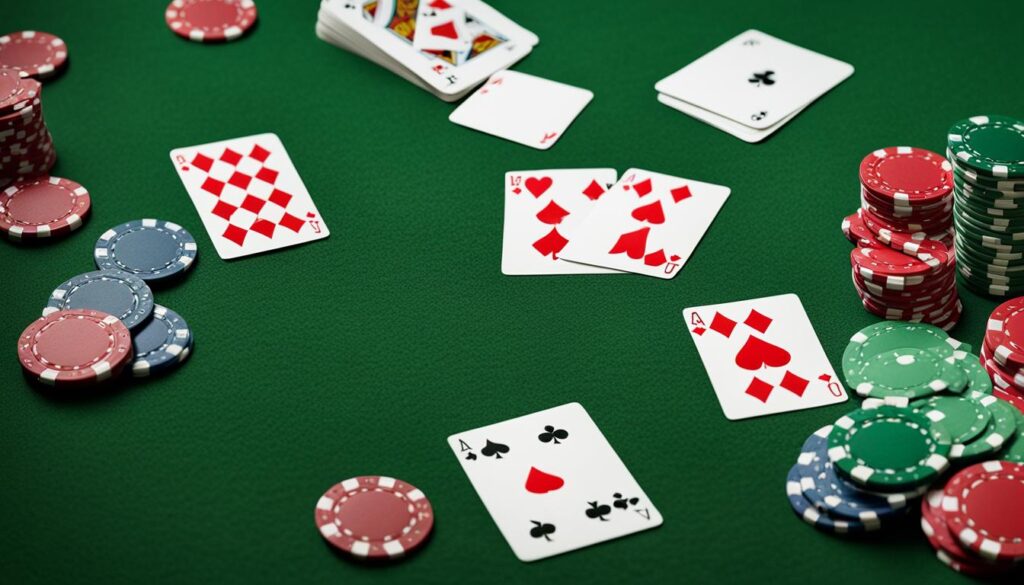
When playing blackjack, encountering a low pair, such as 4s or 5s, can pose a challenge. Knowing the optimal strategy for these hands can significantly improve your odds of winning. In this section, we will explore when to split low pairs, when to hit them, and how the dealer’s hand can influence your decision-making process.
Pair splitting is a strategic move that can be employed when you are dealt two cards of the same rank. The decision to split depends on the dealer’s upcard and the specific rules of the game. In the case of low pairs, it is generally advisable to split them, as it increases your chances of building two strong hands.
However, there are exceptions to this rule. For instance, if the dealer’s upcard is a 5 or 6, it may be more favorable to opt for hitting instead of splitting. The reasoning behind this is that the dealer’s weak upcard increases the likelihood of them busting. By hitting, you have a chance to improve your hand and potentially win even if you don’t split the pair.
| Pair | Dealer’s Upcard | Optimal Strategy |
|---|---|---|
| 2s | 2-7 | Split |
| 3s | 2-7 | Split |
| 4s | 2-4 or 5-6 | Split or Hit |
| 5s | 2-9 | Split |
| 6s | 2-7 | Split |
It’s important to note that these strategies may vary slightly depending on the specific rules of the game and the number of decks in play. Always consult the basic strategy chart for the particular variant you are playing to ensure optimal decision-making.
Blackjack Payout
In blackjack, the payout can vary depending on the casino. While most casinos offer a standard 3:2 payout for a blackjack hand, some establishments may opt for a 6:5 or even-money payout. Understanding the different payouts and their impact on the game is essential to maximize your winnings and make informed decisions at the table.
Table: Blackjack Payout Comparison
| Payout | House Edge |
|---|---|
| 3:2 | 0.5% |
| 6:5 | 1.4% |
| Even-Money | 2.3% |
As shown in the table, the 3:2 payout has the lowest house edge at just 0.5%. This means that for every $100 wagered, the casino can expect to retain only $0.50 in profit. On the other hand, the 6:5 payout increases the house edge to 1.4%, while the even-money payout further raises it to 2.3%. These differences may seem insignificant at first, but over time, they can significantly impact your overall profitability and chances of winning.
It’s important to note that casinos offering the 6:5 or even-money payout often do so to compensate for other player-friendly rules, such as allowing surrender or doubling after splitting. However, in most cases, players are better off seeking casinos that offer the standard 3:2 payout, as it provides a more favorable playing environment and increases the likelihood of long-term success.
Blackjack Probability Explained
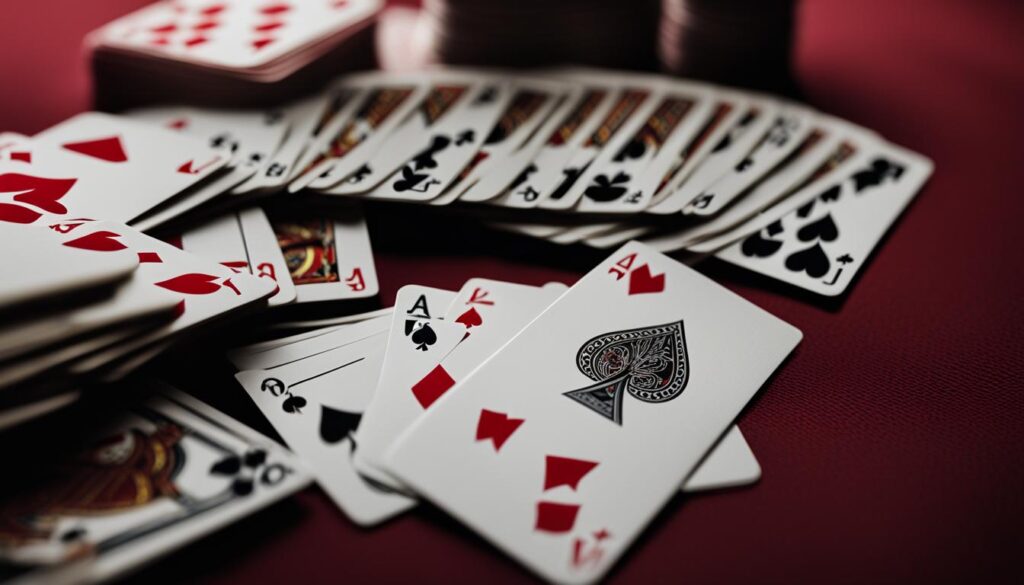
Understanding the probability in blackjack is essential for making informed decisions and improving your chances of winning. The outcome of the game depends on several factors, including the bets made, the cards in your hand and the dealer’s hand, and the cards remaining in the deck(s). By adopting a basic strategy and practicing with online blackjack games, you can gain a better understanding of the blackjack probability and maximize your potential winnings.
When it comes to blackjack probability, the composition of the deck(s) plays a crucial role. Knowing the number of high and low cards remaining in the deck(s) can help you make strategic choices. For example, if there are many high cards left, the probability of getting a strong hand increases, and you may want to consider doubling down or standing. On the other hand, if there are mostly low cards remaining, hitting may be a more favorable option.
Another important aspect of blackjack probability is understanding how basic strategy can influence the game’s outcome. Basic strategy provides a mathematically optimal way to play each hand, taking into account your total hand value and the dealer’s upcard. By following basic strategy, you can minimize the house edge and increase your chances of winning. It’s important to note that basic strategy may vary depending on the specific rules and variations of blackjack you are playing.
| Hand Value | Dealer’s Upcard | Action |
|---|---|---|
| Hard 12 | 4, 5, 6 | Stand |
| Hard 16 | 9, 10, Ace | Hit |
| Soft 18 | 9, 10, Ace | Hit |
Table: Examples of Basic Strategy Actions Based on Hand Value and Dealer’s Upcard.
By considering the blackjack probability, analyzing the composition of the deck(s), and following basic strategy, you can make better decisions and increase your chances of winning. However, it’s important to remember that blackjack is still a game of chance, and no strategy can guarantee consistent wins. Practice and experience will help you develop your understanding of blackjack probability and improve your overall gameplay.
House Edge in Blackjack
When it comes to casino games, every player wants to understand the house edge—the statistical advantage the casino holds over the player. In blackjack, the house edge plays a crucial role in determining the casino’s profit margins. Though the house always has an advantage in any casino game, blackjack offers one of the most favorable house edges. However, with the right strategies and techniques, players can further reduce this edge and increase their chances of winning.
So, what exactly is the house edge in blackjack? Simply put, it is the percentage of each bet that the casino expects to win over the long run. For example, if a game has a house edge of 1%, it means that, on average, the player will lose 1% of their total bets. In blackjack, the house edge typically ranges from 0.5% to 1%, depending on factors such as the specific rules of the game and the player’s skill level.
The house edge in blackjack is determined by several factors, including the rules set by the casino. Common rules that can increase the house edge include using multiple decks in the shoe, paying out blackjack at a ratio of 6:5 instead of the standard 3:2, and requiring the dealer to hit on a soft 17. By understanding these rules and choosing games with more favorable conditions, players can reduce the house edge and improve their chances of winning.
It’s important to note that while reducing the house edge in blackjack can improve your odds, it does not guarantee consistent winning. The outcome of each individual hand is still determined by random chance, and the house edge only represents the average over a large number of hands. Nonetheless, by implementing strategic gameplay, taking advantage of favorable rules, and making informed decisions, players can maximize their chances of success in this popular casino game.
Composition-Dependent Strategy
When it comes to blackjack strategy, most players are familiar with the concept of basic strategy. However, there is another strategy that can further optimize your gameplay and reduce the house edge – composition-dependent strategy (C-D). Unlike the total-dependent basic strategy, which considers only the total value of your hand, C-D strategy takes into account the specific composition of your cards.
By considering the specific composition of your hand, you can make more precise decisions that maximize your odds of winning. For example, with a multi-card 16, total-dependent basic strategy would advise you to hit. However, with composition-dependent strategy, you may find that standing is the better option, depending on the cards in your hand and the dealer’s upcard.
“Composition-dependent strategy allows players to make more nuanced decisions based on the specific composition of their hands, rather than relying solely on the total value.”
Implementing C-D strategy can lead to a significant reduction in the house edge compared to total-dependent basic strategy. A complete table showcasing the differences between these two strategies, based on a double-deck game, is provided below:
| Hand Composition | Total-Dependent Basic Strategy | Composition-Dependent Strategy |
|---|---|---|
| Hard 12 vs. 2 | Hit | Stand |
| Hard 16 vs. 10 | Hit | Stand |
| 10-2 vs. 6 | Stand | Double Down |
As shown in the table, using C-D strategy in a double-deck game can reduce the house edge by 5.3% compared to total-dependent basic strategy. This highlights the importance of considering hand composition when making decisions at the blackjack table.
Percent Reduction in House Edge
When it comes to blackjack, understanding the house edge can greatly impact your chances of winning. Incorporating the right strategies can lead to a significant reduction in the house edge, increasing your odds of success. One such strategy is the use of composition-dependent (C-D) strategy, which takes into account the specific composition of the cards in your hand.
C-D strategy goes beyond the traditional total-dependent basic strategy by considering the individual cards in your hand. This nuanced approach allows for more precise decision-making, resulting in a further reduction of the house edge. For example, compared to total-dependent basic strategy, using C-D strategy with a double-deck game can reduce the house edge by 5.3%. This is a significant improvement that can greatly increase your chances of coming out ahead.
Impact of C-D Strategy on House Edge
By incorporating C-D strategy into your gameplay, you can make more informed decisions that take into account the specific composition of your hand. This can lead to a better understanding of the probabilities at play and ultimately reduce the house edge. The table below illustrates the potential percent reduction in the house edge when implementing C-D strategy:
| Number of Decks | Total-Dependent Basic Strategy | Composition-Dependent Strategy | Percent Reduction in House Edge |
|---|---|---|---|
| 1 | 0.48% | 0.42% | 12.5% |
| 2 | 0.55% | 0.29% | 47.3% |
| 6 | 0.66% | 0.20% | 69.7% |
As you can see, the use of C-D strategy can have a significant impact on the house edge, particularly with a higher number of decks. Implementing this strategy allows for more precise decision-making based on the composition of your hand, resulting in a higher chance of success.
Summary
Incorporating C-D strategy into your blackjack gameplay can lead to a substantial reduction in the house edge, ultimately increasing your odds of winning. By considering the specific composition of your hand, you can make more informed decisions that take advantage of favorable card combinations. The percent reduction in the house edge varies depending on the number of decks and the specific strategy employed. Understanding the impact of C-D strategy allows you to maximize your chances of success at the blackjack table.
Hand Interaction
Hand interaction is a strategic technique that allows players to reduce the house edge and increase their chances of winning in blackjack. By collaborating with other players’ hands and making strategic choices, players can take advantage of profitable doubles, splits, and side bets, ultimately improving their odds of success.
One type of hand interaction is participating in profitable doubles or splits. For example, if a player has a pair of eights and another player has a ten, collaborating on a split can increase both players’ chances of winning. Similarly, if a player has a hand with a value of 11 and another player has a hand value of 5, collaborating on a double can lead to a more favorable outcome for both players.
Another form of hand interaction involves buying or collaborating on advantageous hands. This strategy allows players to join forces with another player’s hand to increase the likelihood of success. By observing the dealer’s upcard and the composition of the player’s hand, players can make informed decisions about whether to buy or collaborate on a particular hand.
Additionally, making profitable side bets can also be a form of hand interaction. Some blackjack variations offer side bets that can provide additional opportunities for players to win. By strategically placing side bets based on the composition of their hand and the dealer’s upcard, players can further reduce the house edge and increase their chances of winning.
Benefits of Hand Interaction
The use of hand interaction strategies in blackjack can offer several benefits. Firstly, it allows players to make more informed decisions and increase their chances of winning by collaborating with other players’ hands. This collaborative approach can lead to a stronger hand overall and improve the odds of success.
Furthermore, hand interaction can help players reduce the house edge, which is the statistical advantage held by the casino. By strategically leveraging the collaboration of other players’ hands, players can minimize the casino’s advantage and enhance their own odds of winning.
It is important to note that hand interaction strategies require a thorough understanding of the game and confidence in decision-making. Players must assess the composition of their hand, the dealer’s upcard, and the potential benefits of collaboration before implementing hand interaction strategies.
Conclusion
Hand interaction is a valuable strategy in blackjack that allows players to reduce the house edge and improve their odds of winning. By collaborating with other players’ hands, making strategic choices, and leveraging side bets, players can increase their chances of success in the game. However, it is crucial to have a strong understanding of the game and the specific circumstances before implementing hand interaction strategies. With practice and experience, players can master the art of hand interaction and enhance their overall blackjack experience.
Conclusion
In conclusion, understanding the odds of winning blackjack with perfect strategy is essential for maximizing your chances of success. By learning and implementing basic strategy, you can significantly reduce the house edge and improve your overall blackjack odds. Remember that even small deviations from basic strategy can have a significant impact on your long-term winnings, so it’s crucial to adhere to the recommended plays.
Additionally, considering hand compositions through composition-dependent strategy can further enhance your blackjack odds. This advanced technique takes into account the specific composition of your hand and allows for more precise decision-making. By utilizing composition-dependent strategy, you can exploit favorable situations and increase your probability of winning.
Finally, hand interaction strategies, such as collaborating with other players’ hands or taking part in profitable doubles or splits, can also help reduce the house edge and improve your blackjack odds. While these techniques require confidence and a deep understanding of the game, they can be highly profitable when employed correctly.
In summary, winning at blackjack with perfect strategy is achievable. By mastering basic strategy, incorporating composition-dependent strategy, and utilizing hand interaction strategies, you can tilt the odds in your favor and increase your chances of winning. Practice, adapt to specific situations, and always keep in mind the importance of understanding the blackjack odds. With dedication and strategic play, you can become a successful blackjack player.
FAQ
What are the odds of winning blackjack with perfect strategy?
The odds of winning at blackjack can be as high as 42.22% if you employ perfect strategy.
How can basic strategy reduce the house edge in blackjack?
Basic strategy and card counting techniques can improve the return-to-player percentage (RTP) and reduce the house edge.
What factors can affect the dealer’s odds in blackjack?
The dealer’s odds can change depending on the blackjack house rules, such as whether they must hit or stand on a soft 17.
What is the probability of winning at blackjack?
The probability of winning at blackjack varies depending on the blackjack variant, the rules, and the player’s playing style.
How can I improve my odds in blackjack?
Use basic blackjack strategy to make smarter decisions and increase your chances of winning.
How can I win tricky hands in blackjack?
Understanding the blackjack odds for tricky hands, such as hard 16 against a dealer 10 or 12 against a dealer 4, can help you make the right choices and increase your chances of victory.
When should I split low pairs in blackjack?
Splitting low pairs like 4s or 5s is recommended in certain situations, depending on the dealer’s upcard.
How does the blackjack payout affect the game?
The blackjack payout can vary depending on the casino, and it can affect the house edge and the overall blackjack probability.
How does blackjack probability work?
Blackjack probability depends on various factors such as bets made, the cards in your hand and the dealer’s hand, and the cards remaining in the deck(s).
What is the house edge in blackjack?
The house edge in blackjack is the statistical advantage the casino holds over the player, ensuring the casino’s profit margins.
How does composition-dependent strategy impact the house edge?
Composition-dependent strategy takes into account the specific composition of the cards in your hand, reducing the house edge even more compared to total-dependent basic strategy.
How much can the house edge be reduced with composition-dependent strategy?
Using composition-dependent strategy with a double-deck game can reduce the house edge by 5.3% compared to total-dependent basic strategy.
What is hand interaction in blackjack?
Hand interaction is a technique that allows players to reduce the house edge by betting on or collaborating with other players’ hands.
How can I increase my chances of winning at blackjack?
By understanding the odds, utilizing the right strategies and techniques, and practicing, you can increase your chances of success in blackjack.
